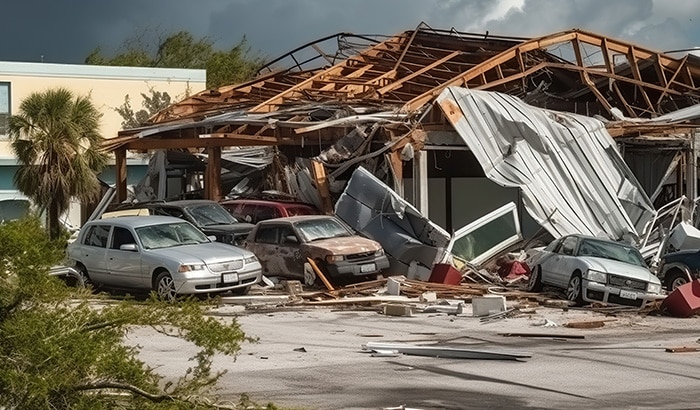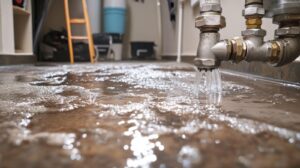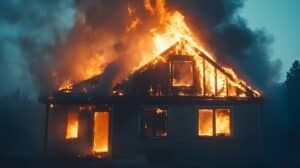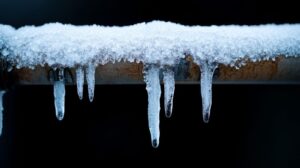Severe storms and natural disasters can wreak havoc on homes and communities, leaving a trail of storm damage and destruction in their wake.
From powerful tornados to severe thunderstorms, the aftermath of natural disasters requires immediate attention. Your longing for normalcy can become hindered over and over again as you navigate this stressful time. Emergency storm damage repair and restoration is a critical process that will help mitigate further damage and help get your life back on track.
Today, we’re covering what to expect when faced with the aftermath of a storm and the steps involved in the restoration process. This information will help you have all your ducks in a row if you’re ever faced with an unexpected accident.
The Impact of Storm Damage
Storms come in various shapes and sizes and, as such, leave an array of destruction behind. Before we dive into the restoration process, here are several ways a storm might devastate your property so you know what to expect:
- Roof Damage: High winds or intense weather can peel off shingles, cause dents and cracks, and compromise the roof’s overall structure. When you experience storm damage on a roof, a roofing or storm damage restoration company can help repair it to working order again.
- Flood Damage: Flooding occurs when there is an overflow of water onto normally dry land. Floods are typically caused by heavy rainfall, snowmelt, dam failure, or tsunamis. Proper flood restoration and cleanup entail several steps to ensure no mold, structural issues, or other problems prevail.
- Tree Damage: Falling trees or wayward branches are a common reason for storm damage on a roof. Falling trees can damage the structural integrity of your home, wreck your roof, disrupt electrical systems, or even break windows. Tree damage can pose serious safety risks and should be dealt with promptly.
- Structural Damage: The force of a storm can weaken the structural integrity of buildings, leading to extensive repairs or an overall collapse. Common signs of home structural damage include cracked walls, leaning chimneys, unaligned doors, cracked or sloping floors, and dampness in the basement. If you observe any of these signs, act quickly and seek professional assistance for emergency storm damage repair.
- Electrical Damage: Electrical systems are often the victim of a vicious storm. If lightning strikes your home, a surge of electricity will pass through. If this happens, it’s possible to short your electrical system and cause permanent damage. Downed power lines, electrical shorts, and power outages can pose a risk of electrical fires.
- Mold and Mildew: Lingering moisture from storms can cause unwanted mold and mildew to sprout. Heavy rainstorms, hail, and flooding can all leave behind a trail of mold that can be harmful and frustrating to deal with. A restoration company can assist you in mold remediation so that you can enjoy your property again without fear of illness.
Steps in the Restoration Process
- Initial Assessment and Planning: The first step when handling emergency storm damage repair is to assess the extent of the damage. Call in the professionals who will check for storm damage on a roof, structural damage, electrical hazards, and other safety concerns. They’ll address any immediate threats first and discuss the plan to tackle all other issues with you.
- Securing the Area: After the initial assessment, restoration professionals will secure the affected area to prevent further damage and keep everyone safe. This might involve temporary fencing, warning signs, or other barriers to restrict access to potentially dangerous areas.
- Water Extraction: If your property has suffered from flooding, extracting the water and drying the area is the next priority. Powerful pumps and dehumidifiers will remove the standing water and excess moisture from the affected area. This will help prevent further damage and allow the crew to mitigate other issues.
- Debris Removal: Removing debris and hazardous materials is an essential step in the storm damage repair process. After a storm, there’s usually a significant amount of debris, such as fallen trees, loose branches, broken glass, and down power lines. All this must be removed for the restoration team to work efficiently and safely.
- Structural Repairs and Reconstruction: This step involves reconstructing any compromised foundation or load-bearing walls. It might also include repairing roofs, electrical systems, plumbing, roads, bridges, or other essential structural components.
- Cleaning and Sanitation: After the structural repairs are complete, thorough cleaning and sanitization will prep the affected areas and make them livable again. This includes mold remediation, disinfecting all surfaces, and addressing environmental concerns.
- Restoring Utilities and Essential Services: Your restoration crew will also focus on restoring utilities and other essential services like electricity, water, sewage, and more.
- Content Restoration: Any personal belongings that were damaged by the disaster are assessed, cleaned, repaired, or replaced.
- Preventative Measures: After the restoration work is complete, measures are taken to help prevent future storm damage, such as reinforcing the structure.
- Final Inspection: A thorough final inspection is carried out to ensure that all restoration work has been completed and is safe to inhabit again.
- Documentation and Insurance Claims: Your restoration team will help you navigate insurance claims throughout this process and work with your provider to facilitate a smooth claims process.
Selecting a Professional
Finding the right fit for your storm damage restoration needs doesn’t need to be complicated. Consider the following points when searching for the right company to handle the storm’s aftermath.
- Insurance Relations: Does the restoration company have experience working with insurance companies? You’ll want to choose a company that knows how insurance payments work and what is expected of them when working with home insurance companies. The insurance world is confusing, and your restoration company should be equipped to navigate it properly.
- Experience: Storm restoration is a complex process that warrants proper expertise. Some restoration might require mold remediation, fire damage restoration, or chemical spill clean-up. The restoration company needs to know how to handle a variety of circumstances and prove its expertise.
- Certifications: Only select a restoration company that has the proper credentials. Licensing requirements vary by location, so check with local and state authorities to ensure the company complies with all necessary regulations.
- Emergency Response: Disaster can strike at any time of day, and it doesn’t always wait for regular business hours — choose a restoration company that can be reached 24/7 and offers emergency response services.
- Transparency: Your restoration company of choice should be transparent with their services, pricing, and the way they do business. Ask for a detailed estimate of the costs involved in the restoration and see what they’re willing to include. They should openly discuss the cost of labor, materials, equipment, and any additional charges that might apply.
- Local Knowledge: It’s beneficial for a restoration company to be very familiar with local building codes, laws, weather patterns, and the most common types of storm damage in your area. That way, they will be better equipped to handle your specific restoration needs.
Insurance and Storm Damage
Insurance plays a vital role in storm damage restoration. This process can be costly, and you deserve the peace of mind that insurance has your back. Here are some key points to consider when navigating the insurance world:
- Understanding Your Policy: Thoroughly read your policy to understand what is and isn’t covered. Meet with your insurance agent if you have any questions.
- Prompt Reporting: When disaster strikes, report it to your insurance company as soon as possible. Delayed reporting can lead to complications in the claims process and delays in restoration.
- Documenting the Damage: Take as many photos and videos of the damage as is safe to do so. This documentation is invaluable during the claims process, as it provides evidence of the extent of the damage.
- Communicate With Your Adjuster: Your insurance adjuster will assess the damage and determine the value of your claim. Keep that line of communication open and provide any documentation they request.
- Compare Estimates: Compare the estimate from your restoration company with the estimate provided by the adjuster. They should be consistent in addressing the same damages.
Call Black Diamond Water Damage and Disaster Restoration for Prompt Recovery
When disaster strikes, you need restoration services that can handle all your storm damage needs. Trust the experts at Black Diamond Restoration to be your go-to source.
With our comprehensive range of services and commitment to excellence, we are dedicated to helping communities rebuild and recover from the devastating effects of natural disasters. Our licensed and certified professionals will help you through the restoration process, restoring your home or commercial space to exacting standards.
Black Diamond Water Damage and Disaster Restoration is ready to serve all your restoration needs — 24/7. We’re based in Murray, Utah, and proudly serve Salt Lake City and the surrounding areas. With over twenty years of Disaster Restoration experience, we do it all, and we do it right! Contact us today to learn more about our services.
toto slot






